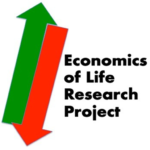
The Economics of Life Research Project (ELRP) was initiated in 1974 to study the economics of productive individuals’ and productive business owners’ lives. The Doctors Economic Research Project (DERP) focused on the economics of doctors’ lives. The Economics of Life Research Project (ELRP) focused on the economics of business owners’ and other non-doctors’ lives, and the Permanent Endowment Research Project (PERP) studied ways in which personal values could be perpetuated through charitable giving.
Two questions were asked of the more than 500,000 attendees who participated in economic education seminars that presented findings of the research over three generations. The questions were:
- What do you need to KNOW to succeed financially?
- What do you need to HAVE to succeed financially?
Findings of the research projects identified that business owners and other productive individuals needed to understand compound interest in the context of their own life expectancies. Two models were developed, one to illustrate a productive individual’s economic life cycle, and another to illustrate the priority allocation of their earnings.
At the request of productive individuals participating in the research projects, the capability to quantify these models in personal, individualized circumstances was created, and planning programs were developed to implement planning principals and rules that were derived from findings of the research projects. More than 65,000 doctors, business owners, and other productive individuals participated in research-based earnings management, savings management, and endowment creation planning programs. Information gathered from planning program participants was accumulated to create the largest data base in existence on the economics of doctors’, business owners, and other productive individuals’ lives.
The planning principals are:
- Don’t lose earnings to unnecessary income taxes.
- Don’t lose savings to unnecessary risk investments.
Two planning objectives were identified:
- To achieve financial independence.
- To achieve personal significance.
Financial independence was defined as guaranteed life income that equals lifestyle costs. Personal significance was defined as the giving of surplus savings to family members and/or to non-profit organizations to perpetuate values of importance to givers, to their families, and to society.
The achievement of financial independence is the goal of the capital accumulation phase of a productive individual’s economic life cycle, and the achievement of personal significance is the goal of the capital distribution phase of a productive individual’s economic life cycle. Planning rules were developed from findings of the research projects to monetize financial stability and financial independence for productive individuals by maximizing the efficiency, control, and safety of the conversion of earnings to savings in the capital accumulation phase and by maximizing the efficiency, control, and safety of the conversion of savings to spending for lifestyle costs and gifting to support values in the capital distribution phase.
Preventing losses of earnings to unnecessary income taxes led to a study of tax law to identify provisions of the internal revenue code that maximized the efficiency of the conversion of earnings to savings, and the conversion of savings to spending and gifting. Maximum efficiency was defined as preventing periodic losses of principal to maximize compound interest growth. Maximum control was defined as personal ownership of savings. Maximum safety was defined as guarantees of savings by government regulated institutions.
Only the legal reserve life insurance industry operated under provisions of the law that provided for institutionally guaranteed principal, guaranteed non-taxed growth, and guaranteed life income. Commercial banks provided access to insured principal and taxable growth, and investment banks provided access to risk of principal and taxable growth. Periodic losses of savings destroy the efficiency of compound interest.